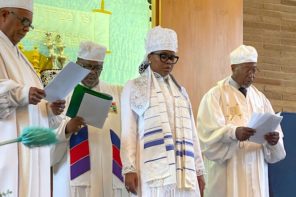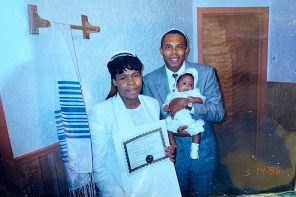An editorial in the Forward calls it a “turning point” in American Judaism. The Kol Nidre service at Occupy Wall Street has blossomed into something bigger: Occupy Judaism.
Jane Eisner, the Forward editor, writes that what is “novel” about Occupy Judaism “is that it challenges the establishment on several fronts,” not just a “direct affront” to party politics, but an “audacious display of empowered Judaism, conducted without the authorization of Jewish officialdom.”
Daniel Sieradski, the organizer of the Kol Nidre service, says the movement is “tapping into something that people haven’t had access to other than through marginal Jewish social justice organizations that don’t get attention or support they deserve because people are too busy sending 18 year-olds to Israel to be indoctrinated with hedge fund managers’ money.”
Sieradski is referring to Birthright, which, according to Kiera Feldman’s investigation for the Nation, has spent “$600 million to send more than 260,000 young diaspora Jews on free vacations to the Holy Land,” a journey that was conceived as “the selling of Jewishness to Jews” and which whitewashes the Israeli occupation. It was co-founded by hedge fund manager Michael Steinhardt and is funded by, among others, casino magnate Sheldon Adelson. “Those are two people who have made their living by putting other people in the poor house,” Sieradski added.
Sieradksi likens this moment of the emergence of Occupy Judaism to the one created when Peter Beinart issued his own indictment of the Jewish establishment, charging that it asked American Jews to “check their liberalism at Zionism’s door.”
“We’ve been asked,” said Sieradski, “to check our social justice values at the establishment’s door.”
Sieradski emphasized how many establishment Jewish organizations “do great and important things, like putting food on people’s tables and taking care of the needy,” and advocate for entitlement programs. But, he insisted, that’s not enough. “At the end of the day,” he said, “all major Jewish organizations take their money from the same Wall Street bankers who put us in this economic situation.”
The focus of the Kol Nidre service Sieradski organized was on our collective role in the financial system, and “focused on our responsibilities as Jews,” he said. He admires Jewish social justice organizations of which he’s “very, very, very supportive, I’m here because I want to bring more people to be connected to the Jewish community and to organziations in the Jewish community. But I want hold the leadership of the mainstream Jewish institutions that are taking money hand over fist from Wall Street.”
The “Jewish establishment,” Sieradksi charged, “is subject to oligarchs who dictate the terms of our communal relationship.”
“I don’t want to be a schlepper for Jewish oligarchs,” he said, who “propagandize Jewish children about their Jewish values and conservative Zionism.”
Eisner writes that Occupy Judaism presents an opening for Jewish activism in an age in which religious political advocacy has been dominated by conservative evangelicals, eclipsing, for younger Jews, a time “when rabbis like Abraham Joshua Heschel marched for civil rights, and Arthur Waskow created a Freedom Seder, and Catholic priests and nuns were instrumental in anti-war agitation, their actions propelled by a fervent religiosity and expressed in liturgical terms.”
So far word of Occupy Judaism has spread by word of mouth and by social media. Sieradski says people responded to the Kol Nidre service with statements like “this was the most meaningful Jewish experience of my life.”




